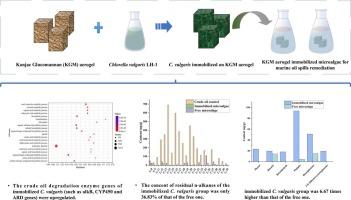魔芋葡甘露聚糖气凝胶固定化微藻:海洋溢油修复的新途径
IF 4.9
3区 环境科学与生态学
Q1 ENVIRONMENTAL SCIENCES
引用次数: 0
摘要
研究了魔芋葡甘露聚糖(KGM)气凝胶固定化小球藻LH-1的油污修复能力。KGM气凝胶孔隙率高达86.83%,随着原油浓度(1 ~ 10 g/L)的变化,KGM气凝胶对原油的吸附效率可达18.75%。KGM气凝胶载体可使油芽草的原油降解效率提高13.86%。培养14 d后,固定化组的残留正构烷烃浓度仅为游离组的36.83%。结果表明,固定化乌耳草原油代谢产物中苯甲酸、邻苯二甲酸和二苯甲酮含量分别是游离乌耳草的1.35倍、21.18倍和3.43倍。与游离组相比,固定化组的9个单加氧酶基因、11个双加氧酶基因和2个细胞色素P450基因在基因本体(GO)分析中表达上调,“碳氢代谢过程”显著富集(富集因子为0.85)。上述结果表明,KGM气凝胶固定化载体的存在,提高了寻常草对原油的降解能力。本文章由计算机程序翻译,如有差异,请以英文原文为准。

Konjac glucomannan (KGM) aerogel immobilized microalgae: A new way for marine oil spills remediation
This study investigated the oil pollution remediation ability of konjac glucomannan (KGM) aerogel immobilized Chlorella vulgaris LH-1 (C. vulgaris). The KGM aerogel exhibited a high porosity of 86.83 %, and with the change of crude oil concentration (1–10 g/L), the crude oil adsorption efficiency of KGM aerogel was up to 18.75 %. The KGM aerogel carrier enhanced the crude oil biodegradation efficiency of C. vulgaris by 13.86 %. The concentration of residual n-alkanes of the immobilized C. vulgaris group was only 36.83 % of that of the free C. vulgaris group after 14 days of cultivation. In the crude oil metabolites of immobilized C. vulgaris, the concentrations of benzoic acid, phthalic acid, and benzophenone were 1.35, 21.18 and 3.43 times higher than those of the free C. vulgaris, respectively. Compared with free C. vulgaris group, 9 monooxygenase genes, 11 dioxygenase genes and 2 cytochrome P450 genes of immobilized C. vulgaris group were up-regulation and the “hydrocarbon metabolism process” was significantly enriched (enrichment factor is 0.85) in the gene ontology (GO) analysis of the transcriptome of C. vulgaris. These results showed that the ability of C. vulgaris to degrade crude oil was improved due to the existence of the KGM aerogel immobilized carrier.
求助全文
通过发布文献求助,成功后即可免费获取论文全文。
去求助
来源期刊

Marine pollution bulletin
环境科学-海洋与淡水生物学
CiteScore
10.20
自引率
15.50%
发文量
1077
审稿时长
68 days
期刊介绍:
Marine Pollution Bulletin is concerned with the rational use of maritime and marine resources in estuaries, the seas and oceans, as well as with documenting marine pollution and introducing new forms of measurement and analysis. A wide range of topics are discussed as news, comment, reviews and research reports, not only on effluent disposal and pollution control, but also on the management, economic aspects and protection of the marine environment in general.
 求助内容:
求助内容: 应助结果提醒方式:
应助结果提醒方式:


